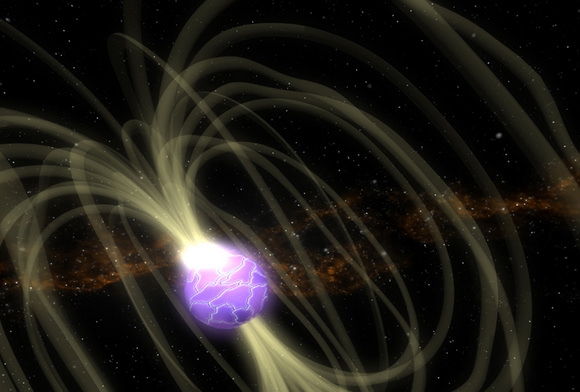

Gamma-rays flares from SGR J1550-5418 may arise when the magnetar's surface suddenly cracks, releasing energy stored within its powerful magnetic field. Credit:NASA/Goddard Space Flight Center Conceptual Image Lab
[/caption]
NASA’s Swift satellite and Fermi Gamma-ray Space Telescope have keyed in on a rowdy stellar remnant 30,000 light-years away. The object, already known as a source of pulsing radio and X-ray signals, lies in the southern constellation Norma. It kicked out some moderate eruptions in October, but then it settled down again. Late last month, it roared to life.
“At times, this remarkable object has erupted with more than a hundred flares in as little as 20 minutes,” said Loredana Vetere, who is coordinating the Swift observations at Pennsylvania State University. “The most intense flares emitted more total energy than the sun does in 20 years.”
The new object has been cataloged as SGR J1550-5418. Because of the recent outbursts, astronomers will classify it as a soft-gamma-ray repeater. Only six such objects are known to science, and they share the trait that they unpredictably send out a series of X-ray and gamma-ray flares. In 2004, a giant flare from another soft-gamma-ray repeater was so intense it measurably affected Earth’s upper atmosphere from 50,000 light-years away.
The source of the wild emissions is probably a spinning neutron star — the superdense, city-sized remains of an exploded star. Measuring only about 12 miles (19 kilometers) across, a neutron star is more massive than the sun.
While neutron stars typically possess intense magnetic fields, a subgroup displays fields 1,000 times stronger. These so-called magnetars have the strongest magnetic fields of any known objects in the universe. SGR J1550-5418, which rotates once every 2.07 seconds, holds the record for the fastest-spinning magnetar. Astronomers think magnetars power their flares by tapping into the tremendous energy of their magnetic fields.
Fermi’s gamma-ray burst monitor is designed to investigate magnetar flares, and SGR J1550-5418 has already triggered the instrument more than 95 times since Jan. 22. Swift’s X-ray telescope captured the first “light echoes” ever seen from a oft-gamma-ray repeater when SGR J1550-5418 started exploding. Both the halo-like rings and their apparent expansion are an illusion caused by the finite speed of light and the longer path the scattered light must travel. NASA’s Wind satellite, the joint NASA-Japan Suzaku mission, and the European Space Agency’s INTEGRAL satellite also have detected flares from SGR J1550-5418.
NASA continues to progress with the development of the Nancy Grace Roman Space Telescope (RST),…
Our neighbour, the Large Magellanic Cloud (LMC), is rich in gas and dust and hosts…
New research on locomotion techniques that could be used in space exploration is constantly coming…
White dwarfs are the remnants of once brilliant main sequence stars like our Sun. They're…
We all know that asteroids are out there, that some of them come dangerously close…
It’s a familiar sight to see astronauts on board ISS on exercise equipment to minimise…